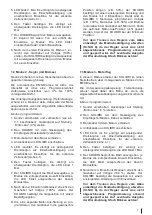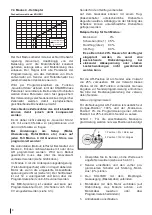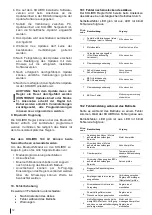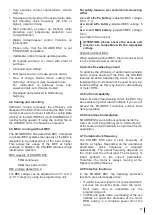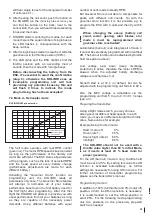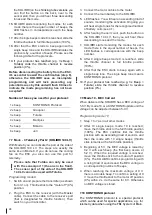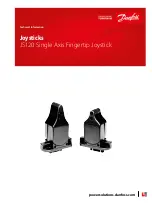
15
Contents
1. Definitions
15
1.1 Delivery content
15
2. Safety instructions
15
3. Basics
16
3.1 Transmitter Preparation for programming 16
3.2 Preparing the mode
16
3.3 Smooth start
16
3.4 Low voltage protection
16
4. General features
16
4.1 Properties
16
4.2 Cooling and mounting
17
4.3 BEC / running without BEC
17
4.4 Active freewheeling circuit
17
4.5 Part load capability
17
4.6 Sensorless Commutation
17
4.7 Variable clock frequency
17
4.8 Protective functions
17
4.9 Helicopter mode
18
4.10 Autorotation (Bail-out)
18
5. Connecting the cables
18
5.1 BEC cables (connection to receiver)
19
5.2 Motor cables
19
5.3 Sensor ports
19
6. Starting
19
6.1 Table of function range for the
19
programmable modes
7. Mode programming
19
7.1 Mode 1 - APM
19
7.2 Mode 2 - Glider (with brake)
20
7.3 Mode 3 - Motor flight
20
7.4 Mode 4 - Helicopter Mode
21
7.5 Mode 6 - Forward / Backward
22
7.6 Mode 7 - Reverse rotation
23
7.7 Mode 8 - Telemetry Port 1
23
7.8 Mode 9 - Telemetry Port 2
24
7.9 Mode 10 - BEC Current
24
7.10 KONTRONIK Protocol
24
8. Updates
24
9. Connecting Bluetooth Module
25
10. Troubleshooting
25
10.1 Errors after connecting the battery
25
10.2 Errors during the operation
25
10.3 Warnings
26
11. Technical assistance, Advice, Hotline
26
11.1Recycling
26
11.2Warranty
26
1. Definitions
APM
Auto-Programming-Mode
EMK
electro motive force
EMV
electro magnetic compatibility
AR
Autorotation / Bail-out
BEC
Battery Eliminating Circuit (to power
the receiver from the main battery)
KOLIBRI
KOLIBRI ESC
Button
“Press” button for mode programming
LED
Active light / control
Mode
Operating mode / program
Pitch
Blade angle (rotor blade) top side
1.1 Delivery content
•
1 x KOLIBRI ESC
•
1 x BEC cable (slave cable)
•
1 x telemetry cable with JR connector
•
1 x telemetry cable with mini JST
•
1 x Cooling fan with screws
•
(KOLIBRI 140 LV)
•
1 x Manual
•
2 x Sticker
2. Safety instructions
The KOLIBRI is a product that is designed
exclusively
for
radio-controlled
model
applications. Under no circumstances the
KOLIBRI should be used in manned
applications!
Always ensure sufficient cooling to prevent
overheating of the ESC.
• When connecting the motor and battery to the
ESC, it is very important to keep a sufficient
safety distance from all moving parts of the
aircraft (such as main blades or propellers).
Misuse may result in an unintended motor start.
Any sudden starting of the motor with main
blades or propellers may cause considerable
injuries. Only use the ESC when property and
personal belongings are out of harms way.
• Do not disconnect the ESC from the battery
during operation.
• Electrostatic discharge may damage the ESC.
Ensure adequate grounding if necessary.
• Do not use a mechanically or electronically
damaged ESC as this may result in sudden
failure.
• The ESC may only be operated with batteries.
The use of a power supply is not permitted.
• The ESC is not to be connected in any way to a
110 / 230 V AC socket.
• When using high capacity batteries always
ensure sufficient cooling.
• Extending the battery or motor cables can affect
the EMC characteristics. Any extension of the
cables is at your own risk!
• Only use a tie-meter for current measurements.
Inserted-meter or shunt can damage the ESC.
• When using the BEC (to power your control
system) always connect a fully charged receiver
battery with enough capacity in addition (also
see BEC 4.3). Malfunctions, e.g. by a cable
break, short circuit, slack joint or failure of a BEC
component will lead to a loss of the entire
receiver system.
!
!
Summary of Contents for KOLIBRI 140 LV
Page 14: ...14 ...







